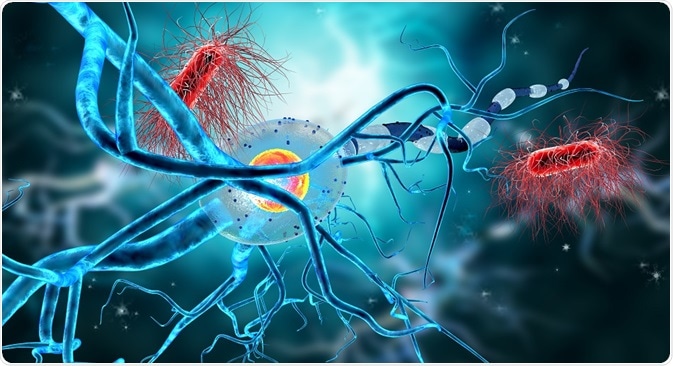Autoimmune encephalitis (AIE) is a term used to describe a group of conditions in which autoantibodies are formed against various antigens present in or on the neurons and appear as neurologic manifestations involving the central nervous system.
 Credit: Ralwel/ Shutterstock.com
Credit: Ralwel/ Shutterstock.com
The severity of the condition often requires intensive care for prolonged periods, and relapses may occur with greater or lesser frequency depending upon the specific condition. However, early and effective treatment may reduce the chance of relapses in some of these illnesses.
Thus a clinical diagnosis is sought to be made without waiting a long period of time for the results of autoantibody testing, and treatment is begun as early as possible following a diagnosis.
Treatment options
Treatment of autoimmune encephalitides includes immunotherapy, either corticosteroids or intravenous immunoglobulins (IVIG).
When the condition is thought to be due to a cell-surface or synaptic protein antibody, IVIG, corticosteroids or plasmapheresis are initiated in various sequences and combinations. However, if the underlying tumor has not yet been diagnosed, steroid therapy might complicate matters, such as for instance in the case of a CNS lymphoma.
IVIG and plasmapheresis, on the other hand, not only avoid this, but will also not exacerbate the condition in the case it is infectious in etiology.
First-line therapy
Provided a synaptic or cell-surface antibody has been detected, and the patient has symptoms suggestive of AIE, first-line therapy is promptly given, as aggressive and early treatment of ill patients, with escalation if improvement is not satisfactory, generally leads to better outcomes and fewer relapses.
First-line therapy consists of intravenous, high dose corticosteroids and IVIG/plasmapheresis. Data is lacking on which is optimum in this situation, so the choice is largely dictated by personal preference and experience.
Autoimmune Encephalitis: Treatment and Expected Outcomes
Failure of first-line therapy to reverse the symptoms occurs in about 50%, and leads to the prompt use of second-line drugs. These may be delayed for no more than 2 weeks, but earlier escalation is often practiced if the patient is comatose or otherwise very ill.
This includes Rituximab, which is a monoclonal anti-CD20 antibody, and its use therefore prevents the employment of plasmapheresis which would remove it from the blood. It rapidly and effectively depletes CD20/CD19 B cells (which secrete antibodies) from the blood to undetectable levels, and is administered weekly for 4 weeks.
It may be used as a single drug in children due to its safety and efficacy against diseases caused by IgG4 antibody reactions.
Cyclophosphamide is an antimetabolite used in chemotherapeutic regimens. It may cause infertility with repeated doses, being shown in 40% of young females after 12 doses, and therefore a GnRH agonist is often used concomitantly, or gametes are collected and stored prior to repeated use.
In children, the same protocols are used with appropriate dose adjustment, but second-line treatment is more likely to be solely rituximab due to the toxicity of cyclophosphamide.
Relapses
Patients with AIE often recover very well or at least partially, but then show acute worsening of symptoms. The relapse symptoms mirror the initial attack but may be milder. In anti-NMDAR encephalitis, for instance, relapse is marked by hallucinations, confusion, memory lapses and new seizures.
About 12% of these patients relapse over the first two years and untreated patients show the highest relapse rate. On the other hand, patients who received second-line therapy have the lowest rate of relapse.
The treatment of relapse is with second-line therapy, though first-line treatment may be tried first. Longer periods of treatment may be employed empirically in the absence of data regarding the optimal duration of treatment of relapses.
An interesting new finding is the possibility of anti-NMDAR encephalitis developing several weeks after a primary attack of herpes simplex virus (HSV) encephalitis. This is clearly defined by the absence of NMDAR antibodies in the first sample of cerebrospinal fluid (CSF) taken at the time of the HSV episode, but their presence in the second sample at the time of the second attack.
This points to the need to evaluate each episode of relapse on its own, whether the first was infectious or not, and not to dismiss it as immune or infectious based on the earlier attack.
Tumor removal is essential in most cases to remove the source of the antibodies and to improve the prognosis of the tumor itself. One study showed that 50% of patients with a specific AIE (anti-NMDAR) improved with first-line treatment and when tumor removal was present there was almost full recovery in 97% at 2 years.
The remaining patients received either second-line (60%) or no treatment (40%). 78% of the former had a good outcome at 2 years compared with 55% of the latter.
Behavioral and psychotic symptoms may require the use of antipsychotics. Their use may precipitate other symptoms especially extrapyramidal, and further complicate the presentation. Again, autonomic instability or rigidity due to the AIE may be mistaken to be neuroleptic malignant syndrome if antipsychotics have been administered.
Steroids may cause psychosis, however, benzodiazepines and clonidine, among others, may help induce sleep in sleep-deprived individuals. Benzodiazepines also are useful in the treatment of catatonic features. Plasmapheresis often requires the use of such agents to secure the cooperation of the patient due to the psychotic and behavioral abnormalities.
Prognosis
Prognostic factors included:
- Less severe symptoms at presentation
- Non-ICU admission
- Early therapy
- Second-line treatment in case of failure of first-line therapy
Overall mortality was about 7% and related to autonomic disturbances in the acute stage or complications of care.
These principles need to be confirmed by studies on other forms of AIE to be applied universally.
Further Reading
Last Updated: Feb 26, 2019